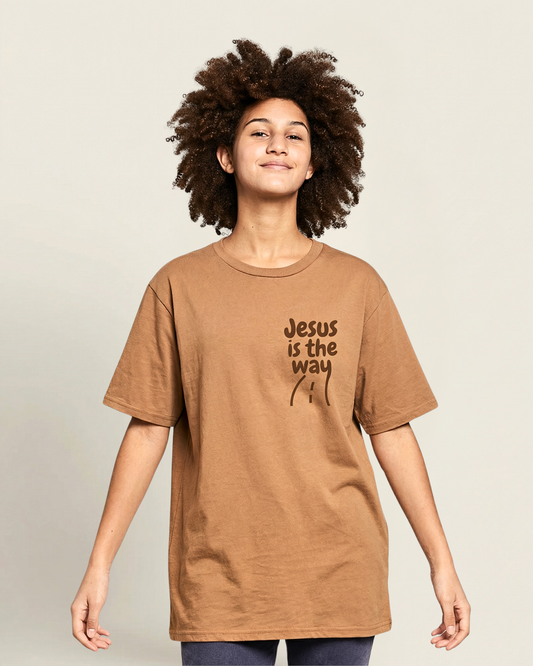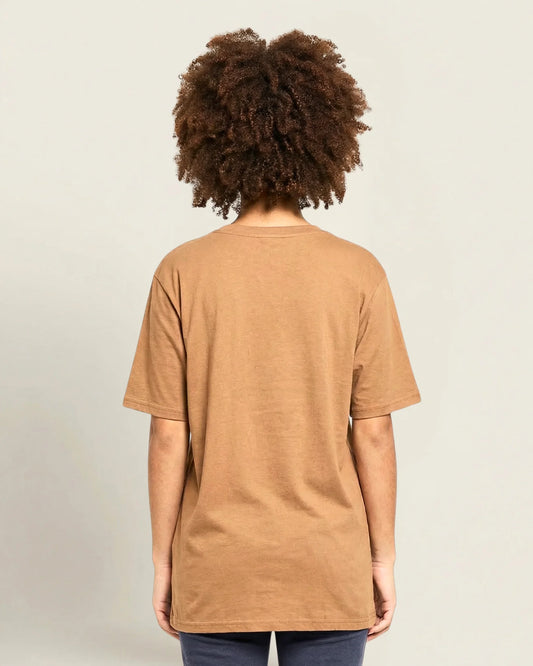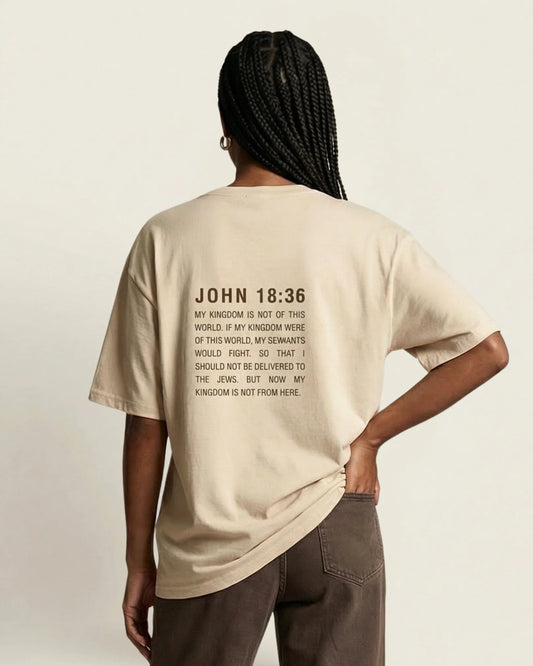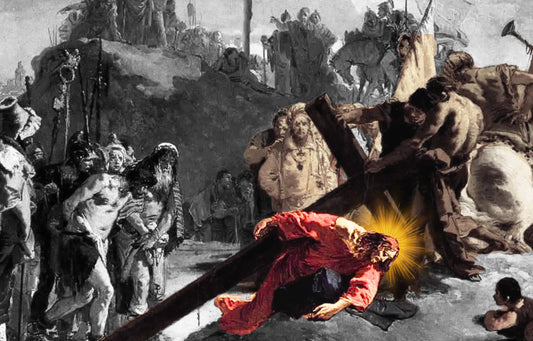Table of content
Jesus Clothing
While we struggle to obtain specific details, we can rely on biblical, historical, and archaeological sources to paint a picture of Jesus' attire. For centuries, people have depicted Jesus in ways that reflect their own cultures. However, we can reasonably approximate his wardrobe to include a tunic, a cloak, a belt, and sandals. Each piece had a practical purpose and expressed simplicity, humility, and a connection with ordinary folk. Saint Cyprian even considered Jesus' tunic as a symbol of the unity of the Kingdom of God.
1. Robe of Christ

A prominent feature of Jesus' wardrobe was his seamless tunic (χιτών, chiton in Greek). It was woven in one piece without seams. It was mentioned in John’s Gospel and symbolizes Christ’s priesthood and the unity of his kingdom. The tunic had a loose fit and a wide neckline. It extended to the ankles, longer than the knee-length, typically worn by slaves and laborers at that time.
Then the soldiers, when they had crucified Jesus, took his garments, and made four parts, to every soldier a part; and also his coat: now the coat was without seam, woven from the top throughout.
2. Jesus' Shawl (Mantle/Cloak)

Historian Joan Taylor notes that Jesus wore a prayer shawl, known as a tallit or tallis, which featured tassels (tzitzit) as commanded in Numbers 15:37-41. It was usually undyed or dyed in light colors and decorated with notched bands in reddish brown or blackish-blue.
This garment is referenced in the Gospels, such as Mark 6:56 and Luke 8:43-47, where people sought to touch the fringe of his cloak for healing in everyday life. It offered warmth, served as a blanket, and even transformed into an impromptu bag when necessary. Women also wore mantles, but they were often dyed darker and wrapped differently.
3. Jesus' Sandals

Sandals (σανδάλια, sandalia in Greek) were an important part of Jesus’s dress. They preserved his feet while he walked on the rough terrains of Judea. Typically made from leather, these sandals had straps that fastened them to the feet. They also served as a physical reminder of his presence during his earthly ministry and symbolized his approachability.
Biblical references highlight their importance; for instance, Mark 1:7 notes that John the Baptist felt unworthy to untie Jesus' sandals:
After me comes the one more powerful than I, the straps of whose sandals I am not worthy to stoop down and untie.
In Mark 6:9, Jesus instructs his disciples to wear sandals as they embark on their mission: "But be shod with sandals; and not put on two coats." The importance of sandals was greater than just their utility as footwear. In biblical times, taking off one’s sandals was an act of profound reverence and humility. We see this act very clearly in the story of Moses at the burning bush.
4. Jesus' Belt

Belts (ζώνη, zone in Greek) were essential accessories in first-century attire. Jesus’ belt helped him keep his tunic in place. This allowed him to move freely as he preached and traveled. Over and above function, belts had a symbolic meaning. They represented readiness and preparation, which was a major part of Jesus' teaching about being ready for the kingdom of God. Luke 12:35: "Let your loins be girded about, and your lights burning;".
Biblical references further illustrate their significance; for instance, Matthew 3:4 describes John the Baptist wearing a leather belt, while Acts 21:11 recounts Paul's belt being used in a prophetic demonstration. Jesus likely wore a simple belt that aligned with his message of humility and rejection of materialism (Matthew 6:19-21).
5. Jesus'Staff

Biblical references suggest that Jesus did in fact carry a staff (ράβδος, rabdos in Greek). Psalm 23:4: "Yea, though I walk through the valley of the shadow of death, I will fear no evil: for thou art with me; thy rod and thy staff they comfort me."
For Jesus, a staff would have been a useful tool for providing support while walking on uneven terrains of Judea and Galilee, and represented his position as the good shepherd for his followers. John 10:11: "I am the good shepherd: the good shepherd giveth his life for the sheep."
Colors and Materials
Colors of Jesus' Clothing

The Bible provides limited information about the specific colors of Jesus' clothing; it suggests that he wore a simple, practical garments typical of a first-century Jewish man, so his tunic most likely had earthy tones. The first-century Judean color palette was very limited compared to today’s choices. Common colors included natural shades like off-whites, browns, and grays, which came from undyed wool and linen. Natural dyes from plants and minerals provided muted colors such as gentle reds and yellows. For example, madder root provided red, and saffron or weld could produce a yellow shade.
Fabrics That Jesus Wore
Jesus robe was likely made from wool or linen. This choice of simple, durable clothing wasn't just a matter of economics. It was reflective of deeper values of humility and accessibility. By wearing this apparel, Jesus identified with the common man. He wore simple clothes to demonstrate that life is spiritual richness, not material wealth. The Gospels highlight these distinctions, particularly in his trials before figures like Herod.

Jesus' Attire in Major Events
Transfiguration Event Clothing
During the Transfiguration, Jesus' clothes shone brilliantly, whiter than anyone could ever bleach them. Mark 9:3:"And his raiment became shining, exceeding white as snow; so as no fuller on earth can white them." This change was dramatic, revealing his divine nature to his followers. The difference between his typical humble clothing and the brilliant robes represents the intersection of the earthly and the divine.
Entry into Jerusalem
Jesus likely wore his signature tunic and cloak while riding on a donkey. Matthew 21:7-9: "They brought the donkey and the colt and put on them their cloaks, and he sat on them." His modest garb and mount were a statement in themselves – he was a king of humility, peace, and love. It proclaimed loudly what the kingdom really was — not grandiose, but servitude and love.

Crucifixion Garments
During the crucifixion, they took away Jesus' clothes, leaving only a seamless tunic (John 19:23). They cast lots for this tunic, fulfilling prophecy. Psalm 22:18: "They part my garments among them, and cast lots upon my vesture." The seamless tunic is often seen as a symbol of unity and wholeness. These moments illustrate how clothing shaped the story of Jesus' life and death, revealing deeper truths and promises.
Resurrection Attire: Glory in Humility

After rising from the dead, Jesus appeared not in dazzling robes but in humble simplicity. When Mary Magdalene first saw Him, she mistook Him for a gardener (John 20:15)—suggesting ordinary work clothes rather than heavenly splendor. Yet His resurrected body still bore the scars of the Cross (Luke 24:39), transforming wounds into eternal proof of His victory.
The folded grave clothes left in the tomb (John 20:6–7) tell their own story: death’s shrouds discarded, replaced by a body that could appear, vanish, and even eat (Luke 24:41–43). Unlike the Transfiguration’s radiant light or the Cross’s stripped-away tunic, Jesus’ resurrection appearances reveal a glory that meets us in everyday life—miraculous yet intimate.
Common Misconceptions About Jesus' Appearance
Long Hair and Beard Myth
The iconic image of Jesus with long hair and a beard is largely based on artistic renderings, not historical evidence. In first-century Judea, men typically kept their hair short for practical reasons. Jesus likely had short hair, as suggested by Paul's statement that long hair on men was disgraceful (1 Corinthians 11:14). He probably had a small to medium-sized beard, common among Jewish men of the time.

White Robes
The idea of Jesus always wearing white robes is primarily based on artistic representations symbolizing purity. Historically, most people in Judea wore undyed fabrics in brown, beige, or gray. Expensive dyes were uncommon. Jesus, living among common people, dressed humbly, reflecting His teachings (Matthew 6:28-29).
Ornate or Kingly Attire Misbelief
The notion that Jesus wore luxurious or kingly attire contradicts historical records and His teachings. Jesus identified with the poor and emphasized simplicity (Matthew 8:20). His clothing was similar to that of everyday people in first-century Judea.
Lessons We Can Learn From Jesus' Clothing

Simplicity in Lifestyle
Jesus preferred simplicity in his clothing choices, modeling a life not bound by material wealth (Matthew 6:19-21). His simple garments represented a life of purpose over possessions, connecting to modern minimalism. This simplicity allows for meaningful connections with others, valuing people over possessions (Luke 12:15).
Inner Character Focus
Jesus focused on inner character rather than outer appearance (1 Samuel 16:7). His teachings encouraged looking beyond surface appearances (John 7:24). Clothing may influence how people see us, but it shouldn't define us. Jesus emphasized authenticity and genuine character (Matthew 23:25-26).
Cultural Adaptation in Ministry
Jesus' clothing demonstrated sensitivity to the culture around him (1 Corinthians 9:19-23). He wore garments familiar to those he ministered to, bridging cultural gaps. This cultural adaptation is crucial in ministry, encouraging authentic relationships and effective communication of hope and love (Acts 17:22-23).














